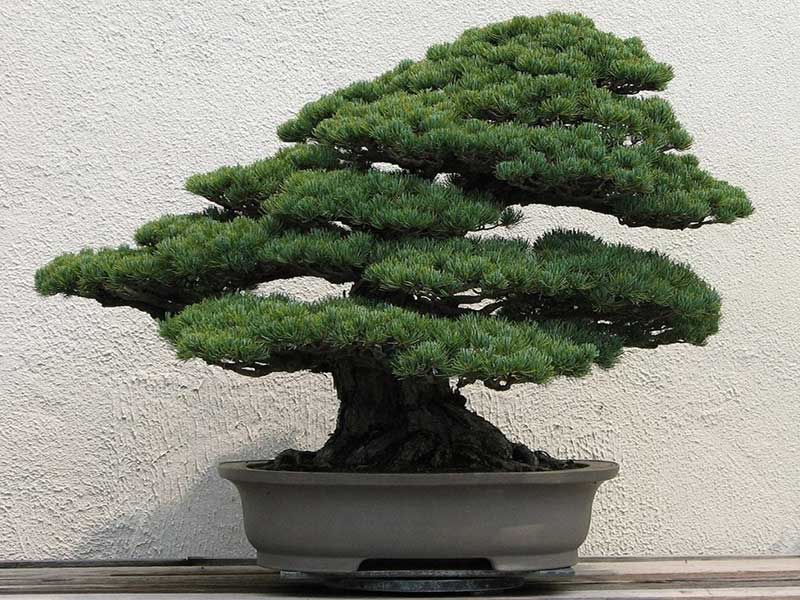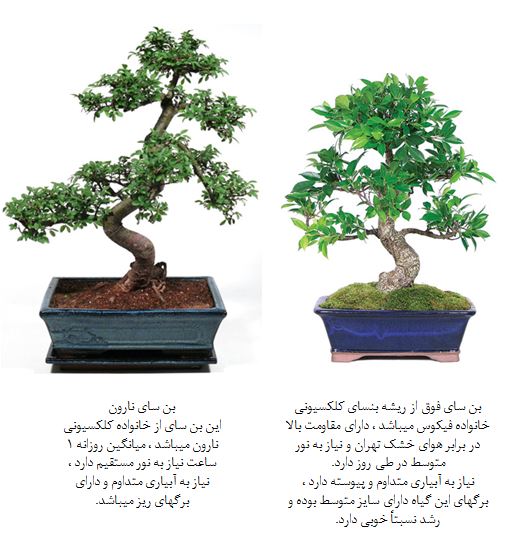Best nutrition conditions, weather, soil, light and lighting of bonsai flowers
Bonsai, Darsan or Japanese nitty-gritty (Japanese: 盆栽) is the art of growing small-sized trees and plants. Bonsai is a tree or plant in a pot that is trimmed in a way that is cleaned and has a height of about 30 to 60 centimeters between the ages of 100 and 200.
Light
Only in the presence of sunlight is the practice of photosynthesis and the conversion of raw materials absorbed from soil and carbon dioxide of air into sugar, possible. If this light is less than normal, the plant naturally raises itself to reach the sunlight, and as a result, the herbaceous, thin, pale and distance between the two nodes increases, and on the contrary, if the sunlight is too much, the plant starts branches to shade itself to escape this danger.
Bonsai tree growers need to know that each plant has certain optical requirements and this is different in different species. For example, pine and reptile cypress or juniper prussia are two needle-leaf plants in mountainous regions whose optical requirements are full sunshine, and if this bonsai plant is kept in a shaded place, it grows and almost stops. If kept next to the wall, the bonsai juniper plant of Prussia, if kept next to the wall, its upward side of the wall grows little or no, and the outside side of the wall begins to grow more.
The Japanese maple tree and the Azalea shrub are two almost delicate semicircular and forest-loving plants. If these two bonsai are in the open air, it grows better because it is far from light and produces much stronger branches. The Japanese maple, which has compromised itself with the shade of the semicircle, retains its color in these conditions, but if exposed to intense sunlight in early autumn, the autumn copper red color will be developed and better.
In Bonsai's art, they always observe the average level of caution, but some artists, just the opposite, believe that principles should be properly observed. The truth is that intense light or shadow will neither completely destroy your plant nor grow very well. The last point is to rotate your bonsai plant 90 degrees every day to get all directions of the plant equally light.
Water
Bonsai plants are more exposed to waste than exposed to dehydration due to excessive irrigation. Some species like high water in saturated soil, but some plants like drought better for a while of the year. Typically, these plants like soil that holds moisture and will never tolerate excessive dryness.
By testing the soil and removing a small amount of it with fingers, soil moisture content can be determined. If the soil is bone dry, irrigate the pot immediately.
Water quality:
Rainwater is undoubtedly the best quality for irrigating bonsai plants. Unfortunately, it is not possible to store large amounts for a long time because spores of pathogenic fungi such as phytophotra contaminate water barrels, which in case of irrigation with such waters, root spoilage is certain. It is recommended that the containers of water be tightly closed if rainwater is stored. Some bonsai species are quite sensitive to calcium in water (Calcifuges). Considering that irrigation of the aerial parts of the plant is done with geyser, calcium element of water on the leaves has a burn effect.If irrigation water has such characteristics, the use of acidic soils will neutralize the effect of calcium water. Irrigation with these hard waters for a long time causes root scaling, which is due to excessive calcium deposition around the roots, which is raised by capillary pipes in the soil and manifests itself as dandruff on the surface of the pot. Dandruff should be removed with a special delicate broom. Never use light or artificially filtered water for irrigation because sodium in these waters has replaced calcium, which is far more dangerous. Mineral waters have the necessary elements and minerals for the human body, especially fluorine for dental health. If the concentration of these elements does not exceed normal levels, none of them are harmful to the plant. To disinfect drinking water, they are chlorinated if you use these waters for irrigation, pour them in an open container for about a few hours to release the chlorine.
One of the important points in irrigation is the degree of water waste. Very hot and very cold waters both shock the hairy roots. Water temperatures in summer should be slightly colder than the root environment and about one or two degrees warmer in winter. If you keep a larger number of bonsai pots and water with hoses or fountains, be careful with the high temperature of the water remaining in the hose.
Irrigation
One of the most common methods of irrigation is irrigation from the top of the soil, especially since pot drainage is suitable for the disposal of excess water. It seems useful to mention a few points in this regard.
• Attach a delicate fountain to the mouth of a hose or faucet and adjust the water pressure so that the water cannot wash the pot soils and condense the rest of the soil.
• Slowly fill that volume from the edge of the golda n which is intended for irrigation and after sitting
Irrigate again. Make sure the drainage and excess water are eschewed.
• If after second-order irrigation the excess water is not removed from the drainage vent or the soil is completely compressed and dense or the vent is blocked that you have to replace the pot and because the replacement season may not have started, water the pot by flood irrigation method.
• Never irrigate one side of the gold as the roots on the other side of the pot remain dry and obviously the branches on the same side will remain weak.
• Do not try to irrigate all plants equally. Irrigation should be done at once and immediately. Visit the soil of the pots regularly to adjust the irrigation round.
• Rinse the aerial organs when irrigating. Water-soluble foods sprinkled with geysers on the aerial organs may remain powdered on the leaves after evaporation of water. A few hours after the rinse with a nutrient solution, rinse the leaves with pure water.
• The residual water droplets on the leaves act like lenses to pass sunlight, resulting in the burning of leaves, and therefore, geysers should not be carried out in the summer sunlight from 11 to 6 p.m.
Flood Irrigation
With the closure of pot vents or soil condensation and poor drainage conditions, you should resort to flood irrigation. In this method, fill the water and gently place the goldan inside and wait for the water to occupy the entire surface of the soil. With the outflow of air bubbles, it turns out that the water has penetrated deep into the soil. If you do not see bubbles, replace the pot and soil as soon as possible.
Automatic irrigation
Mass producers of bonsai somehow use automatic irrigation either drip or rainy, but due to the different water requirements of different plants, it is difficult to adjust a certain amount of water for the plant. Although this method can be a good help for irrigation when you are not at home for a relatively long time, it is not suitable for the maintenance of bonsai in general.
Air
Plants, like humans and other organisms, need oxygen to survive, whether in their aerial environment, which should be constantly flowing air or in the root environment, which is supplied by drainage and good soil texture, otherwise the oxygen-free environment provides the best conditions for the nasal and spores of pathogenic bacteria and fungi of plants. Cigarette smoke also torments bonsai plants, the branches inside the plant wither and the leaves are piped, and the leaves become susceptible to the attack of fungal whites, and the trunk and soil surface are filled with algae.
In order to use more oxygen in the indoor environment (room and greenhouse), the bonsai plant must be placed slightly above ground because the air in this area flows better than low and high levels. Above it is hot and dry air and lower cold air. The flow of air is at a reasonable and acceptable level with put.
Above that, hot and dry air and lower cold air is the flow of air at a reasonable and acceptable level by exposing the plant to strong, cold, hot and dry winds and such winds make the plant suffering from drought and early autumn. Not only high winds, but moderate-speed winds are also detrimental to Bonsai. Plants such as Japanese maple and azalea, if exposed to moderate winds, their leaf margins tend to be brown.


